Disturbing Legacy
I am visiting my family’s tomb. It is in Nettuno, a small seaside town one hour’s train ride from Rome. The last time I was here I was nine years old, and I am now a retired professor. Over half a century has passed and I had been afraid I’d find broken slabs of marble with bones sticking out. But no, all it needs is a good cleaning.
It is a lovely structure. Most mausoleums are made of solid marble-enclosed, forbidding, deeply cold rooms. Ours is made of warm travertine, into which four large arches are carved. Air happily goes right through. As a monument to death, it is strangely light.
I walk up to the railing and peer below. The human-sized marble slabs are mercifully intact, all eight of them. I also see piled-up dirt and trash, including a still-red McDonald fries container and a broken plastic vase, dry stems sticking out.
I can read all the names, and most of the dates. Five of the tombs are inscribed, three are blank. My great-grandfather Pietro Talenti and his wife Palmina Sacco Talenti are there, together behind one marble slab. All their children are there too: the firstborn is Pier Carlo, my grandfather, and with him is Lina Egidi, my dear grandmother.
Then come Italia, Achille, Anita. Of all these siblings, only one produced a child, and this child was my father, the son of all these souls united, the only heir. My father’s name is Pier Francesco, son of Pier Carlo, son of Pietro. He and his wife were destined to inhabit this tomb, but he is not among them, even though he died years ago, in 1997. Why?
Perhaps I could ask the ancestors? Why not clean their tomb, do them honor. Really, nothing to lose; I like the beautiful and unusual structure.
Leading down from the gate are steep steps made of alternating marble blocks, one for each foot. It is a steep journey. Once you are below you can touch the tombs, the names, the dates. You stand there with the living, eyeing the dead, as clouds drift above, framed by arches.
I press the lever in the gate, but it’s locked. I keep trying, it won’t give way. The gate is tall, but the railing is only waist-high. Should I attempt to scale it, then hop over to the landing above the steps? It seems perilous, and three graves over two cemetery attendants in blue worker’s suits stand: they would be sure to stop me.
I see that nearby is a rack with brooms, dustbins, and water cans, all neatly lined up. One one-Euro coin unlocks one broom and one dustbin. I take them and start sweeping the outside of the tomb.
As I sweep the debris I see a swastika appear on the ground, part of the tiled border around the tomb. I had all but forgotten it: when I last saw it I was nine years old and didn’t know much. But now the swastika feels abhorrent, shocking. They’ve won that one, the Nazis, there is no question that the symbol has come to overwhelmingly represent them, and only them, and this evokes horror in almost all of us.
I hear my stepmother’s voice, a memory from the last time I was here: “no no no, it’s not Nazi,” says Tania, tense. “The legs point the other way, it’s a Hindu symbol, obviously.” She must have been talking to Lina my grandmother, because I knew nothing of swastikas then.
I am in a different era now, and my phone quickly avails me of the image. Tania was wrong: the swastika here is clockwise, like the Nazi swastika, not counter-clockwise. Further internet prodding also tells me that the swastika has been present in Eurasian cultures since the Late Stone Age. The name itself comes from Sanskrit, means “leading to well-being.” In Hinduism, when set clockwise it symbolizes the sun, when counter-clockwise the night. In Buddhism it is a symbol of the heart-mind connection, for Zeus and Thor it is their lightning bolts. In Italy it is found in the ancient tiles at Agrigento, and at the top of Augustus’s mausoleum in Rome, a black-and-white mosaic frieze, primarily decorative.
Is this what the family meant?
Up at the top of the tomb I find the date 1925, the year my grandfather Pier Carlo died in a car accident. This means his brother Achille must have built the tomb for him, then moved their parents, Pietro and Palmina, here. The year 1925 is well before the Nazis were in power in Germany, but in Italy it is when fascism begins. What on earth possessed Achille? Even if you were a fascist in Italy, you would never use the swastika. You would use the fasces, a bundle of sticks fastened tightly together with an axe, a symbol taken from Roman times, signifying strength in unity.
And I know that Achille Talenti, while a building contractor under Mussolini, was himself anti-fascist. He profited greatly during that era, but he had to hide behind his pro-fascist associate. The name of his firm was Tudini-Talenti. Tudini did little more than carry the fascist card, while Achille did most of the actual work. One of the accomplishments of the firm was building the town of Sabaudia in record time. It is nearby, just south of Nettuno.
I walk around the tomb, looking carefully. The fasces is nowhere to be seen. I find an anchor, a small cross, and a bird with an olive branch in its beak, all small and simple, nothing as imposing as this monstrosity, the swastika. There is one small comfort, possibly insignificant: the swastika here is not tilted at a 45-degree angle, the way the Nazis tilted theirs. This one is stolid and square.
It is so like my stepmother Tania, I think, to paper over a difficult discussion, to prevent uncomfortable probing. She was deeply tense around anything to do with the Nazis. Her own father, whom she adored, had been a money-launderer for the Nazis. He was Jewish, it was his way of surviving, a pact with the devil. This discussion was taboo in our family as I was growing up, but I have since done much research. Her father was a financial genius, but on the wrong side of history: multiple OSS, CIA, newspaper, and magazine reports all point to the nefarious ways in which he acquired his fortune. Still, Tania’s father had nothing to do with this tomb, and neither did she. She married into the Talenti family in 1968, well after the Nazis were defeated.
I continue sweeping around the tomb. I discover three more swastikas on the ground, for a total of four. Each swastika is in the tiled border of the tomb, each is black against white, and each is placed at the center of each arch. The arches are open, it’s what I like about this tomb, atypical, for air and light passes right through, whispers over the dead below. The swastikas feel like force fields, energy fanning out to cover each arch, each entrance. It looks as if the swastikas are meant to protect, to guard each opening. But history has intervened, and I find, sadly, that they now do more than protect: they repel, they make you jump back in horror.
Which is better, uncovering the swastikas or covering them? Keeping them or doing away with them, removing them altogether? Were my family tomb in Germany I would not have a choice: by law any and all swastikas have to be removed when on public buildings and monuments. Only this August, 2020, a swastika was discovered in the mosaic floor of a German art museum, the Kunststätte Bossard.¹ They have temporarily solved the problem by covering it with a carpet. It is a symbol so potent it can provoke two extremes: vandalism by those who hate it, and veneration by those who love it, those who admire the Third Reich. Indeed, Germany is seeing a resurgence of far-right nationalists eager to revive the emblem along with all it represents.
As I stand there leaning on my broom, my eye sets on a piece of paper taped to the side of the broom rack. Three names, three phone numbers, at the top of which is: Ufficio Cimiteriale, Responsabile: Maurizio Carosi. Then two workers’ numbers. No custode.
Look at that! How about calling Mr. Responsabile?! Perhaps this Mr. Carosi knows whether there’s a key, whether I can get into my family’s tomb and clean it. I dial.
“Pronto?”
Happily surprised that he picks up, I quickly explain my situation in Italian. I add that I’ve come all the way from America, which is true, as I hope to encourage a quick resolution.
I hear shuffling, then “Cappella Famiglia Talenti, Numero 1249c, Settore 16?”
“Cappella Talenti, sì!” The rest I don’t know, it’s his way of designating the plot. It shows he knows his stuff.
“Good,” he says, “let’s meet.”
“Is there a key?”
“We can look. Where are you?”
“I’m at the cemetery.”
“Can you meet me there at two?”
“Yes, sure, thank you!”
I hang up, pleased.
What to do between now and two o’clock? Across the street and only minutes away is another cemetery, which locals use as a park, because it is wide and green, and nothing like Nettuno’s overcrowded city cemetery. It is the Sicily-Rome American Cemetery and Memorial, but locals simply call it the American Cemetery.
I put my broom and dustbin back in their rack, and I step out of Nettuno’s cemetery.
White marble crosses cover the broad green lawns of the American Cemetery. The impact is enormous: so many dead, rows and rows of them, all under identical crosses. This military cemetery is similar to Arlington’s National Cemetery, but it is different in that the rows are laid out not in straight lines but in wide repeating arcs, somehow more accepting, embracing, restful. Throughout, tall umbrella pines stand guard, providing abundant shade from above while their thin naked trunks barely take up any space below, respectful.
The dead Americans go as far as the eye can see, yet they are only a fraction of those who served in Italy. Here rest the remains of those who were not repatriated. They fought from Sicily to Salerno, then northward toward Rome, including at the Nettuno-Anzio beachhead only one mile away. Here rest 7,853 souls, and the gentle slope ahead, covered in headstones, make one feel profoundly sad, humbled, and grateful. These young men and women all died fighting fascism, Mussolini, and Hitler.
As I researched my great-uncle Achille Talenti’s life, I ran across a YouTube clip² that features Mussolini laying the cornerstone of Sabaudia, the town Achille had built in a record 253 days. The clip was filmed on August 5, 1933. I searched for a young version of my great-uncle and was delighted when I found him. When Mussolini strides into the construction site everyone raises their right arm. Achille also appears to salute, his shoulders move, but all he does is shift his hat from one hand to the other. His right arm never goes up, a moment of private protest. Later in the clip Mussolini and my great-uncle face off across a table, the contract between them. Mussolini takes his time, gesticulates with great importance. Achille stands opposite him, perfectly still, holding the pen aloft, the straight man to the theatrical buffoon. Mussolini finally signs.
I watch the clip five or six times, at which point an ad pops up: President Trump with his right arm raised and his hand extended in the Roman salute. The redirection startles me. Has an algorithm pegged me in error as a Mussolini admirer?
I also watched clips of Nazis in Paris, Nazi flags waving all over the city, their swastikas popping. A revolting symbol, but a remarkably effective design. My stepmother grew up in Paris, was only fifteen when the Nazis marched in. Watching those clips was my way of trying to imagine her difficult relationship with the regime that brought her nuclear family wealth, even as it exterminated all her other relatives. A Trump ad appeared under each and every clip.
It’s two o’clock, I arrive at my family’s tomb, and I see a man about my age, salt-and-pepper hair, dressed in a crisp polo shirt and blue jeans, ironed, as some Italians do.
“Signora Talenti?” he says.
My grandmother Lina, buried here, was Signora Talenti, then my mother, then my stepmother—it’s my turn now, but it still surprises me.
“Signor Carosi?”
“Sì,” he says, and we shake hands. Next to him are the two workers I saw earlier. I say hello to each, an older one and a younger one. The younger one is out of a Botticelli portrait: the blue of his coveralls, the proud bearing and the perfect lineaments of his face, framed by soft brown curls—give him a Cosimo de Medici–type hat, scarlet red, and we’re there.
“Unfortunately we cannot find a key,” says Mr. Carosi, “but if it is alright with you, we can try to open it.”
“Of course! But how?” I ask.
He nods to the young one, who traipses over to the railing, then swings one leg over. The other leg follows, and he hops over to the landing at the top of the steps that lead below. It’s exactly what I had imagined myself doing but was deterred by these very workers’ presence: I couldn’t exactly break in like that. And I have to admit the young man does it with far more ease than I would have done, since I am quite a bit older and my legs much shorter. I might have ended up splayed below, suddenly joining my dead relatives.
Instead, I have this Botticelli youth examining the latch in the gated door, it bodes well.
“What’s next?” I ask, “It looks like an unusual lock.”
He fishes out a screwdriver from the deep pocket of his worker’s pants and says, “I used to be a thief.”
Mr. Carosi and I nod happily to each other. We lean on the railing. I remember the swastika between us on the ground.
“It’s ugly, isn’t it,” I say, pointing down.
He looks, doesn’t seem surprised, and he nods, agreeing with me, but he adds “it was 100 years ago,” as if distance in time softened the swastika’s sharp angles, what it has come to represent. No, I want to say, the Nazis were defeated in 1945. One hundred years from that would put us at 2045, we’re not there. But I don’t say it, because this is his way of being kind, of trying to make me feel better.
“These Talentis were against Italian fascism,” I say, “and certainly against the Nazis.” As I say it I realize it sounds defensive, a too-rapid excuse, even though it’s true. One might argue my father was a fascist, but he isn’t buried here, his ashes were scattered in San Francisco Bay.
“That’s right,” says Mr. Carosi, “wouldn’t the swastika be reversed if it was Nazi, wouldn’t the legs go the other way?” He’s still being kind.
“Unfortunately not,” I say, “I looked it up earlier.”
Two distinct pieces of metal are at the young man’s feet, he’s jiggling a third one, and soon it’s in his hand. He turns to me and smiles.
“Done?!”
He nods, proud. He waits for us to walk over to the front of the gate, then opens it, majestic.
“Bravo!” I say.
He chuckles, steps out.
I cross under the arch, stand on the marble ledge. Then I begin my descent, tuning in to what my forebears might murmur.
- Thomas Rogers, “Museum’s Future Clouded by Chance Discovery: Swastika Hiding in Plain Sight,” The New York Times, August 11, 2020.
- The video was retrieved at https://www.youtube.com/watch?v=2iOgLYEtyNc.


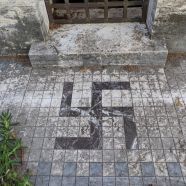





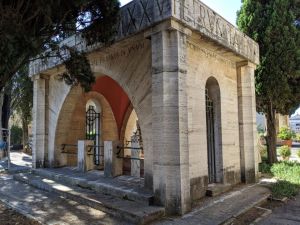
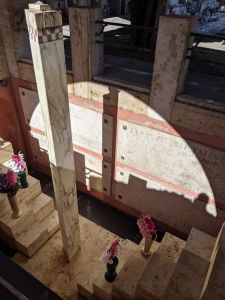
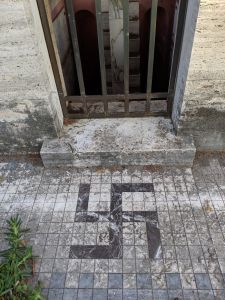
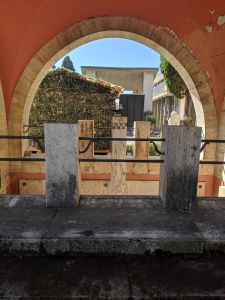
Fascinating story beautifully told. Southerners can relate.
Unsurprisingly, the imagery is wonderful What a good story. But what happened next?
Just now seeing this: didn’t know folks could comment!
Kate, thank you for the comments and the question: this is actually an excerpt of a multi-generational memoir, so there is plenty more…
Beautiful. Chilling. Thank you, Francesca.
Very poignant, Francesca. Thank you for writing this. A quietly important story and you tell it very well.
Wonderfully told, Francesca. A natural storyteller, as befits an Italian by way of the American South.
I loved this. There are so many delicious layers here: history, humor, family and characters. What a wonderful story!
Francesca, reading this was informative, intriguing—just ended too soon. When is the next installment?
So many vivid moments, Francesca. Your voice and story leap off the page. I can’t wait to read the full memoir.
A day in time, and also timeless. Beautifully captured, Francesca. The tomb, erected 95 years ago… yet I am struck by the incursion of the Trump ads. Perhaps the swastikas symbolize the dark wolves 🐺 ever prowling within the thin skin of our humanity…and your family has kept them “at the door”…reminders that we must be ever vigilant?
I love this little piece Francesca, it took me back many years to all those wonderful times that I spent with your family in Netuno, and my own visit to your family tomb.
Surprisingly I had no memory of the swastikas, yet you captured the essence of the place, and I felt a great nostalgia for those sweet days!
Paul
Interestingly enough, I found this article by googling something that is written on a truck in the legendary 1948 movie Ladri di biciclett (Bicycle Thieves). Good read, thank you very much.